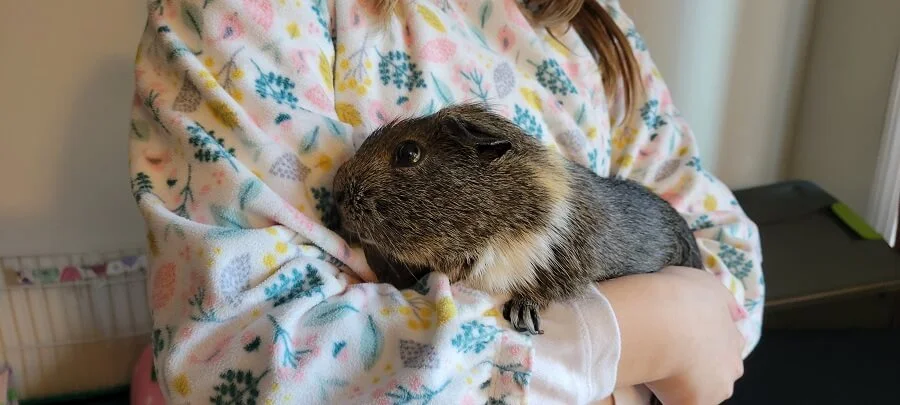Guinea pigs are naturally cautious because they’re prey animals. This means they have special ways they act and react, especially when people are around them. Each guinea pig is different in how they feel about being held.
For those of us who love guinea pigs, it’s really important to understand their natural behaviors. When we get how they think and feel, we can be better at handling and caring for them. This way, we build a relationship with them that’s based on trust and comfort.
Do Guinea Pigs Like to Be Held?
Whether guinea pigs enjoy being held depends on their individual personality and handling experiences. Some love it, enjoying cuddles and lap time, while others prefer exploring on their own. It’s crucial to handle them gently, respecting their comfort level and building trust through positive interactions.
Just like our guinea pig Luna, every guinea pig has its own set of behaviors and comfort zones. Luna, for instance, isn’t fond of being held. Despite this, she shows her comfort around us in other ways. She’ll come close, eat out of our hands, and even purr when we pet her.
This tells us that while she’s comfortable in our presence, but being held feels different to her. She will try everything to get away when we try to pick her up. Sometimes it works, sometimes it doesn’t, but having a 9 year old in the house guarantees daily struggle for Luna.
Here are some signs to look for:
| Signs Guinea Pigs Like Being Held | Signs Guinea Pigs Dislike Being Held |
|---|---|
| – Purring: A sign of contentment, indicating they are comfortable. | – Trying to Escape: Indicates discomfort or fear. |
| – Relaxation: They seem at ease in your arms. | – Freezing: A sign of anxiety or feeling threatened. |
| – Approachability: If they come towards you, it suggests openness to interaction. | – High-Pitched Noises: Expressions of stress or discomfort. |
Observing these signs will help you understand your guinea pig’s preferences. It will ensure a happy, stress-free relationship. While observing your guinea pig’s behavior, you might also want to check out our guide on the signs of guinea pig boredom, which can offer additional insights into their daily habits and preferences.
The Right Way to Hold a Guinea Pig
Holding a guinea pig correctly is crucial for their safety and comfort. Here’s how you can make the experience enjoyable for both you and your furry friend:
- Observe First: Before attempting to pick up your guinea pig, observe their mood. A guinea pig that seems relaxed and curious is more likely to be receptive to being held.
- Approach Gently: Slowly place one hand under their chest and use the other to support their bottom. This way, you distribute their weight evenly and prevent any strain on their delicate body.
- Two-Handed Hold: Always use both hands when lifting your guinea pig. This provides them with a sense of security and prevents any accidental falls.
- Stay Low: Initially, sit down while holding your guinea pig. This reduces the risk of dropping them from a height and makes them feel more secure.
- No Sudden Movements: Move slowly and speak in a soft voice to keep your guinea pig calm. Sudden movements or loud noises can startle them.
- Comfort Is Key: Make sure your guinea pig’s feet are supported. Some guinea pigs feel more secure when all their feet are touching a surface.
- Respect Their Limits: If your guinea pig tries to wriggle away or shows signs of stress, it’s time to gently put them back in their space. Pay attention to their body language, and never force them to stay in your arms.
This not only ensures their well-being but also helps in building a deeper bond based on mutual trust and respect.
For more detailed care tips, especially if you’re a first-time owner, our comprehensive guinea pig care guide is a valuable resource to ensure you’re providing the best for your furry friend.
Building Trust with Your Guinea Pig
Establishing trust with your guinea pig is a gradual but rewarding process. Here are some effective ways to build a strong, affectionate relationship with your pet:
- Patience is Key: Remember, trust-building takes time. Be patient and consistent in your interactions.
- Regular, Gentle Interaction: Spend time near your guinea pig’s enclosure every day. Speak softly and let them get accustomed to your presence and voice.
- Offer Treats: Food can be a great icebreaker. Offer treats from your hand to create positive associations. High-quality, dust-free hay should be their primary food source, but occasional treats can be a delightful bonus.
- Gradual Introduction: Start with putting your hand in the cage and letting your guinea pig approach you. Avoid sudden movements that might scare them.
- Positive Reinforcement: When your guinea pig responds positively to your presence, reward them with treats and gentle petting. This reinforces good experiences associated with your interactions.
- Respect Their Space: If your guinea pig seems uncomfortable or scared, give them space. Forced interactions can damage trust.
By consistently applying these tips, you’ll notice your guinea pig becoming more comfortable. It may even start looking forward to your time together.
Safety and Comfort for Your Guinea Pig
Ensuring the safety and comfort of your guinea pig during handling is crucial. Here’s how you can make each interaction a positive one:
- Create a Safe Environment: Before handling your guinea pig, check your surroundings. Ensure there are no loud noises or potential threats, like other pets, that could startle them.
- Gentle Handling: When you pick up your guinea pig, do so gently and securely. Avoid gripping too tightly, as this can cause fear or discomfort.
- Recognize Signs of Distress: Pay attention to your guinea pig’s behavior. If they try to escape, bite, or show other signs of stress, it’s best to put them back in their enclosure and try again later.
- Health and Comfort Considerations: Be mindful of any health issues your guinea pig may have, like arthritis, which could affect their comfort level with being held.
- Supervise Young Children: If children are interacting with your guinea pig, supervise them closely to ensure they handle the pet gently and understand how to respect its boundaries.
- Regular Cleaning and Care: Maintain a clean and comfortable living space for your guinea pig. A well-cared-for guinea pig is more likely to be a happy, relaxed companion.
Health Considerations When Handling Guinea Pigs
When it comes to handling guinea pigs, their health and physical condition play a significant role. Here are key points to keep in mind:
- Be Aware of Health Issues: Conditions like arthritis or joint pain can make handling uncomfortable for guinea pigs. Always handle them with extra care and gentleness if they have such health concerns.
- Regular Vet Checkups: Routine veterinary visits are important for maintaining your guinea pig’s health. A healthy guinea pig is more likely to be comfortable with being handled.
- Watch for Signs of Discomfort: If your guinea pig shows any signs of pain or distress while being held, such as squirming excessively or making unusual noises, it’s time to gently put them back in their habitat.
- Handling for Health Checks: Sometimes, handling is necessary for health reasons, like nail trimming. In these cases, ensure you’re supporting them securely and comfortably to minimize stress.
Individual Personalities and Preferences
Just like humans, every guinea pig has its own unique personality and preferences, especially when it comes to being held:
- Understanding Individual Differences: Some guinea pigs may love cuddle time. They seek out human interaction. Others might be more independent and prefer to stay on the ground.
- Respecting Their Choices: It’s important to respect these individual preferences. Forcing a guinea pig to be held when they are uncomfortable can harm your relationship and their well-being.
- Observing Their Behavior: Pay attention to how your guinea pig reacts to being held. Do they seem relaxed and content, or are they trying to escape? This will give you a good indication of their comfort level.
- Adjusting Your Approach: Be willing to adapt your handling technique and the amount of time you hold your guinea pig based on their individual personality. Some may require more patience and gradual trust-building than others.
Children and Guinea Pigs
When children interact with guinea pigs, it’s important to consider the safety and comfort of both the child and the pet.
- Supervision is Essential: Always supervise interactions between children and guinea pigs. Children may not understand how to handle these small animals gently.
- Teach Gentle Handling: Educate children on how to properly pick up and hold a guinea pig. Emphasize the importance of being gentle and calm.
- Understanding Guinea Pig’s Body Language: Help children recognize signs of stress or discomfort in the guinea pig, such as trying to escape or making unusual noises.
- Setting Boundaries: Explain to children that guinea pigs need their own space and may not always want to be held.
- Responsibility and Care: Use these interactions as an opportunity to teach children about responsibility, empathy, and the proper care of animals.
By guiding children in how they interact with guinea pigs, you can foster a safe and enjoyable relationship for both. This enhances the well-being of your furry friend.
Conclusion
It is essential to understand and respect your guinea pig’s preferences for being held. This is important for a healthy and happy relationship. By observing their behavior, gently handling them, and building trust over time, you can foster a rewarding bond.
Whether they love cuddle time or prefer their space, your sensitivity to their needs ensures a nurturing and loving environment. Enjoy discovering and cherishing the special moments you share with your guinea pig!

